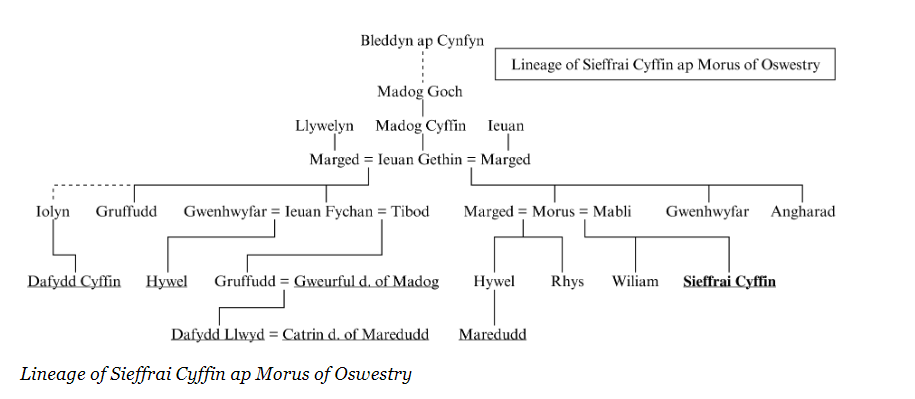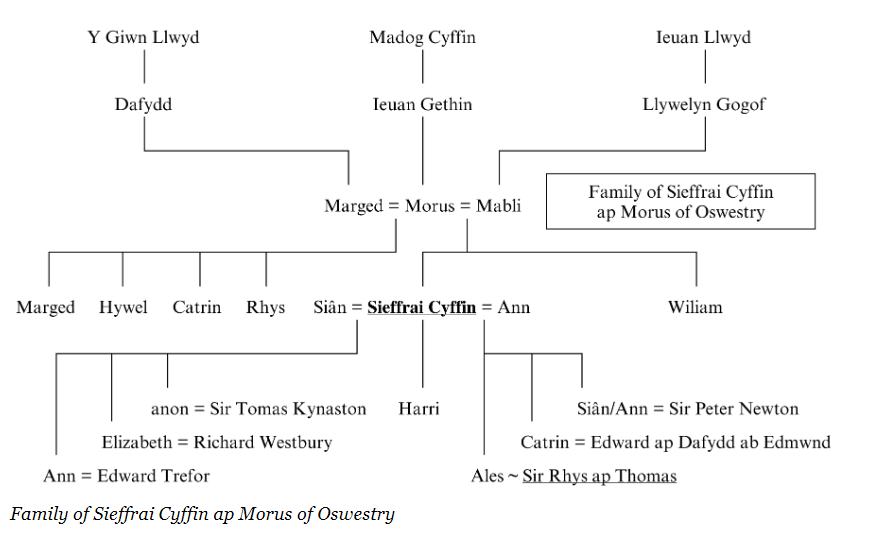 Pedigree of Ann, daughter of Richard Lord
Strange (Guto's Wales)
Pedigree of Ann, daughter of Richard Lord
Strange (Guto's Wales)
"Sieffrai was the grandson of
Ieuan Gethin and was therefore related to an extended family
that exerted substantial influence in the March to the west
of Oswestry during the fifteenth century...Griffith states
that Madog [Cyffin] adopted the surname from a place of the
same name in Llangedwyn (cyffin ‘border, limit’) in order to
differentiate between himself and his father, Madog Goch.
Sieffrai’s father, Morus ab Ieuan Gethin, was the justice of
the commote of Mochnant Is-Rhaeadr during the 1390s and is
mentioned in a record following the failure of the Owain
Glyndŵr revolt. He was alive and associated with Oswestry in
1445. Guto notes that Morus travelled to the town of Arras
in north-east France and to Prussia in Germany, possibly on
a pilgrimage." (Guto's Wales)
"It is likely
that Sieffrai went on a pilgrimage to both Rome and
Jerusalem around the year 1460. Guto refers hastily to the
journey at the beginning of his poem for both him and his
wife, Siân, where he states that Sieffrai visited the church
of St Peter in the Vatican City before journeying to the
port of Jaffa in Israel and visiting the Church of the Holy
Sepulchre in Jerusalem. It is highly likely that Guto
referred to the same journey in another poem for Sieffrai.
Although no mention is made of the pilgrimage, Guto states
that Sieffrai journeyed across the channel to France and
through Burgundy to Greece and Africa. By combining details
from both poems it can be argued that Sieffrai travelled
through Burgundy in order to cross the Alps. According to
Olson, there were three main routes across the Alps in the
Middle Ages. The fact that Lewys Glyn Cothi travelled on a
pilgrimage to Rome by what is known as the ‘German way’
suggests that Sieffrai also crossed the Alps from the same
direction. Lewys states that he travelled (possibly from
Anglesey) to Brabant and Flanders and then down through the
Rhine Valley to Burgundy, from whence he journeyed through
Germany and Swabia (in south-west Germany today) to Lombardy
in northern Italy...William
Wey’s detailed account of his travels sheds some light on
what Sieffrai must have experienced about the same time,
such as the length of the journey and dealings with native
peoples in a variety of different countries. Like most
medieval pilgrims to Jerusalem, Wey travelled to Venice in
order to find a ship that would take him to the port of
Jaffa. It seems that Sieffrai, like Wey, visited Rome first
before going to Venice, where pilgrims would often have to
wait for weeks or months for a ready ship and then for
favourable winds to set sail. Pilgrim ships from Venice
would cross the Mediterranean Sea and stop occasionally on
islands such as Crete and Cyprus before arriving at Jaffa,
from whence the pilgrims would travel to the city of
Jerusalem. Unlike Wey, Sieffrai does not seem to have
returned the same way, for he also visited Africa (Egypt, in
all likelihood). He may have visited Alexandria on his way
home or even journeyed to Mount Sinai." (Guto's Wales)




